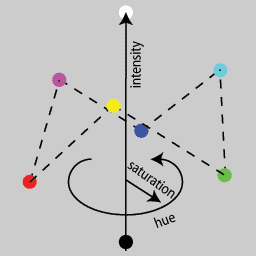Turn the cube so that its diagonal from black to white is vertical. Think of this as the north/south polar axis of the earth. Roughly around the equator you now have a sequence of saturated colours: red, yellow, green, cyan, blue, magenta and back round to red. This is the sequence you see in the normal spectrum of light (the rainbow) except that that does not fold round on itself like this.
We now have a different system of coordinates for describing points in or on the cube. Distance up the polar axis, the grey scale, from black is intensity (this is variously described also as brightness, luminosity or value - all roughly mean the same). Angle around the equator (longitude if you like) is the hue. Distance outwards from the axis is the saturation of the colour: points on the central axis are grey, totally unsaturated colours; points on the equator are fully saturated. Saturation is also sometimes known as chroma. This coordinate system for colour is called HSI (or HSB, HSL, HSV in different books).


